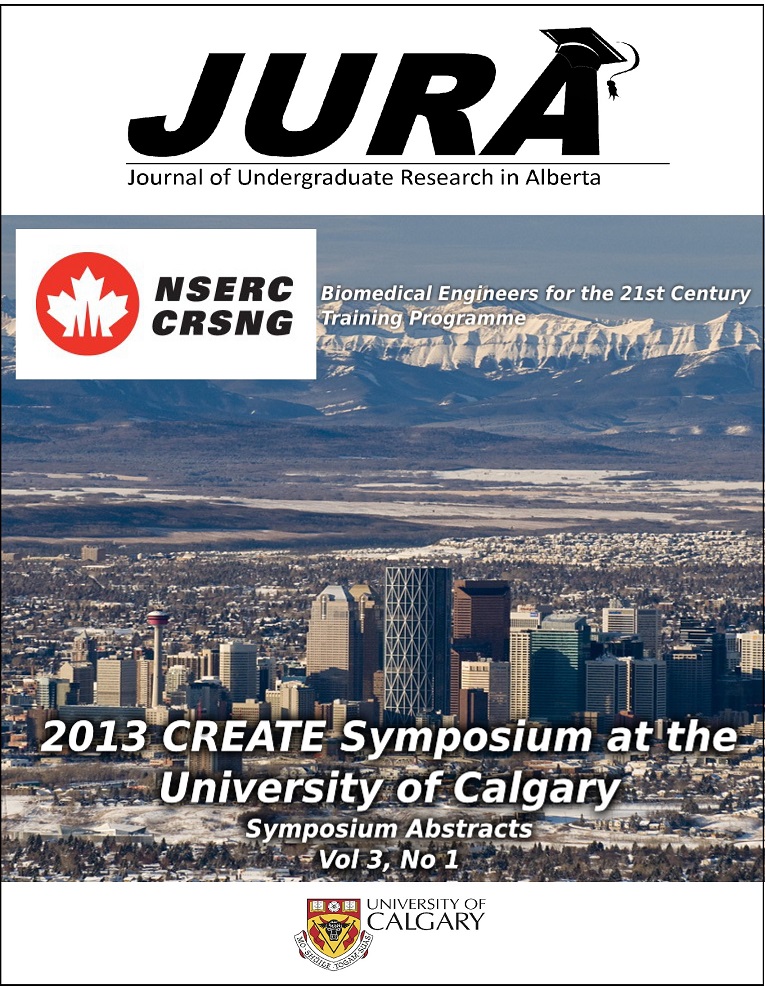Immunolocalization of proteoglycan 4 and hyaluronan on articular cartilage
Keywords:
proteoglycan4, hyaluronan, articular cartilageAbstract
INTRODUCTION
Articular cartilage is a tissue that is designed to reduce friction and be resistant to wear [1]. Proteoglycan 4 (PRG4), a mucin-like glycoprotein, is a lubricating molecule that is found in synovial fluid (SF) [2]. SF also has hyaluronan (HA), a glycosaminoglycan that forms large aggregates with proteoglycans like aggrecan [3]. Friction tests have shown that PRG4 and HA exhibit synergistic effects while lubricating cartilage [4]. HA and PRG4 have both been singularly visualized on the surface of cartilage using immunohistochemistry (IHC).
The objective of this project was to co-visualize PRG4 and HA on the surface of articular cartilage.
METHODS
Cartilage disks (6 mm diameter) were harvested from the femoral groove of mature bovine knees. Samples were either immediately snap frozen (fresh) in OCT embedding medium or were shaken overnight in phosphate buffered saline (PBS) at 4°C to remove SF, and then soaked in 200 μL bovine SF (bSF), or PBS. These samples were then snap frozen in OCT. Samples were sliced (5 μm) and placed on slides for IHC. Slides were washed in PBS, and then fixed with paraformaldehyde. They were washed again, and endogenous peroxidase activity was blocked with H2O2. Nonspecific binding was blocked with normal goat serum. Monoclonal mouse antibody 4D6 was used as the primary antibody for PRG4 and biotinylated-HA binding protein (HABP) was used to detect HA [5.6]. Alexa Fluor 594 goat anti-mouse antibodies and streptavidin PE were used as secondary agents to label the PRG4 and HA, respectively [6]. Slides were sealed with DAPI VectaShield. The slides were imaged with a Zeiss LSM 780 confocal microscope using the 405 nm (DAPI), 488 nm (HA) and 594 nm lasers (PRG4).
RESULTS
HA and PRG4 were co-localized on the surface of fresh cartilage. The binding was shown to be specific, since PRG4 and HA were not observed on samples that did not receive HABP or 4D6. After shaking and soaking in PBS, neither PRG4 or HA were observed on the surface indicating that shaking successfully removed SF from the surface. HA and PRG4 were observed on the shaken samples soaked in bSF, indicating the surface could be repleted with PRG4 and HA.
Figure 1. Image of the surface of: fresh sample (a), fresh sample with no secondary agents (b), shake-PBS soaked (c), and shake-bSF soaked (d). Cells labeled blue. PRG4 red, HA green. Overlap between HA and PRG4 is orange/yellow.
DISCUSSION AND CONCLUSIONS
These results demonstrate that PRG4 and HA are co-localized on the surface of articular cartilage. The signal for PRG4 and HA is specific, and SF can be removed and repleted via shaking and soaking samples. Additional IHC work is required, with PRG4, HA, and PRG4+HA soaks, to determine the order of deposition of PRG4 and HA on the surface of articular cartilage. Further surface interaction assays could also contribute to the understanding of the PRG4+HA interaction.
REFERENCES
1. Buckwalter & Mankin. J Bone Joint Surg. 79A: 612-32, 1997. 2. Drewniak E, et al. A&R. 64: 465–473, 2012. 3. Pearl A, et al. Clin Sports Med. 24: 1-12. 2005. 4. Schmidt T, et al. A&R. 56: 882-891, 2007. 5. Abubacker S, et al. Osteoarthritis and Cartilage. 21: 186-189, 2013. 6. de la Motte & Drazba. J Histochem Cytochem. 59:252–257, 2011.
Downloads
References
2. Drewniak E, et al. A&R. 64: 465–473, 2012.
3. Pearl A, et al. Clin Sports Med. 24: 1-12. 2005.
4. Schmidt T, et al. A&R. 56: 882-891, 2007.
5. Abubacker S, et al. Osteoarthritis and Cartilage. 21: 186-189, 2013.
6. de la Motte & Drazba. J Histochem Cytochem. 59:252–257, 2011.
Downloads
Additional Files
Published
Issue
Section
License
Authors retain all rights to their research work. Articles may be submitted to and accepted in other journals subsequent to publishing in JURA. Our only condition is that articles cannot be used in another undergraduate journal. Authors must be aware, however, that professional journals may refuse articles submitted or accepted elsewhere—JURA included.


